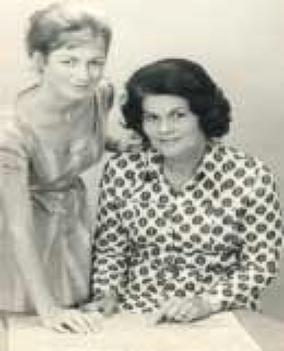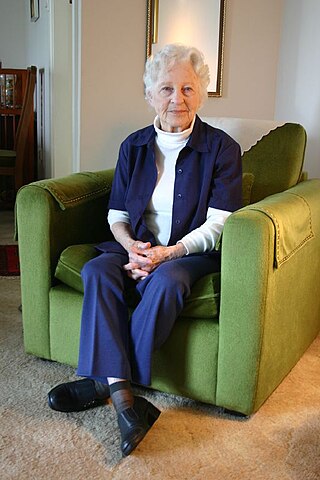
Freda Thompson OBE (5 April 1909 – 11 December 1980) was a pioneer aviator, the first Australian woman to fly solo from the United Kingdom to Australia. [1]

Freda Thompson OBE (5 April 1909 – 11 December 1980) was a pioneer aviator, the first Australian woman to fly solo from the United Kingdom to Australia. [1]
Born at South Yarra, Melbourne Victoria to parents Frederick and Martha Thompson. [2] Thompson was educated at Toorak College in Melbourne leaving with Honours, Proficiency Certificates Pianoforte and Ice Skating. [3]
On 28 May 1930 she did Thompson took her first flight as a pilot and later in that year obtained her A Licence. [2] In 1932 she obtained her 'B' Commercial Pilot licence and became the fifth woman in Australia to hold that license. [2] She qualified as a flying instructor in 1933 and was reported as the first woman in the British Empire to obtain instructors licence. [2] [4]
In April 1934 Thompson sailed for England to collect a new De Havilland Moth Major, which she named Christopher Robin. It had been fitted with long range fuel tanks for the journey to Australia. Thompson had accumulated over 250 hours of flying experience by this time. On 28 September 1934 Freda left Lympne, Kent for the long journey to Australia flying solo. The trip took 39 days with the actual flying time being 19 days. Thompson damaged her aeroplane G-ACUC (VH-UUC) when she made a precautionary landing at Megara, Greece, the flight to Australia was delayed by 20 days waiting for a spare part for a damaged wing. Freda arrived in Darwin on 6 November, and at Mascot, Sydney on 20 November 1934. [5]
Thompson was commandant of the Woman's Air Training Corps in Victoria from 1940–1942. [2] During the course of WWII she applied to join the Women's Auxiliary Australian Air Force but did not receive a response and in 1942 she enlisted in the Australian Women's Army Service. [2] [6]
Following WWII Thompson bought a de Havilland Hornet Moth, and named it Christopher Robin II. She flew extensively within Australia, and in 1952 to the Territory of Papua and New Guinea. She competed in air races and formation-flying events. She won forty-seven trophies. She was president in 1948 of the Royal Victorian Aero Club. By 1980 she had logged 3330 flying hours. [2]
In 1937 Thompson was awarded King George VI's coronation medal and in 1953 she was awarded Queen Elizabeth II's coronation medal. [2] In 1937 Thompson was appointed an Officer of the Order of the British Empire (OBE). [5]
Thompson's papers were donated to the National Library of Australia in 1990, and the collection includes her 1930s air pilot's cap and googles. [3] [7]
In 1994 she was honoured by the issue of a postage stamp by Australia Post, one of a series depicting Australian aviators also including Stanley Goble and Ivor McIntyre, Lawrence Hargrave, Sir Keith and Sir Ross Macpherson Smith. [8] Thompson was inducted onto the Victorian Honour Roll of Women in 2001. [9]

Amy Johnson was a pioneering English pilot who was the first woman to fly solo from London to Australia.

Jane Gardner Batten, commonly known as Jean Batten, was a New Zealand aviator, making a number of record-breaking solo flights across the world. She is notable for completing the first solo flight from England to New Zealand in 1936.

Nancy Bird Walton, was a pioneering Australian aviator, known as "The Angel of the Outback", and the founder and patron of the Australian Women Pilots' Association.

Robin Elizabeth Miller, known as "The Sugarbird Lady", was an Australian aviatrix and nurse. The name "The Sugarbird Lady" was given to her by outback Aboriginal children during her work combatting polio. She died of cancer at the age of 35.

Maude Rose "Lores" Bonney, was a South African-born Australian aviator. She was the first woman to fly solo from Australia to Britain.

Jean Ethel Burns was an Australian aviatrix. She was the first Australian woman to parachute from an aeroplane over Australia and held the title of being the youngest female pilot in Australia for 15 years.

Mary, Lady Bailey, was an Anglo-Irish aviator. She was known as one of the finest aviatrices of her time, who '"personally guided a plane from England to the nether tip of South Africa and back".

Ivy May Hassard (nee Pearce) (8 June 1914 – 26 April 1998) was one of the first female pilots in the southern hemisphere and a pioneer of the Gold Coast, Queensland, Australia. She is noted for her contribution to the cultural development of the Gold Coast, opening the first fashion boutique in Surfers Paradise in 1946.
Deborah Jane Lawrie, known as Deborah Wardley while married, was the first woman to become a pilot with a major Australian airline after winning a landmark sex discrimination case against Ansett Airlines.

Pauline Mary de Peauly Gower Fahie was a British pilot and writer who established the women's branch of the Air Transport Auxiliary during the Second World War.

Ethel Marian Sumner "Maie" Casey, Baroness Casey, AC, FRSA was an Australian pioneer aviator, poet, librettist, biographer, memoirist and artist. Lord Casey was her husband.

Charles James Melrose was an Australian aviator who held a number of flying records, and was the youngest and only solo flier to finish the Melbourne (MacRobertson) Centenary Air Race in 1934.

Flight Lieutenant Charles William Anderson Scott, AFC was an English aviator. He won the MacRobertson Air Race, a race from London to Melbourne, in 1934, in a time of 71 hours.
Early Australian female aviators were generally active since 1927 when it became possible for an Australian woman to hold a pilot's licence and fly within Australia. Women had participated in gliding, or taken a licence overseas, but they had not been permitted to fly a plane under licence within Australia. The first Aero Club in Australia was established in 1915.

May Gertrude Shepherd , was an Australian aviator and the first woman in Australia to hold first class pilot's 'A', 'B' and 'C' licences concurrently, in addition to a 'D' electrical ground engineers' certificate. She was also the first and the only woman in Australia, at the time, known to hold a 'X' certificate in oxy-welding and metallurgy.

Louie Cullen was a British suffragette and hunger striker who emigrated to Australia to continue her feminist activism. She was imprisoned for her activist work, and was awarded a Holloway brooch.
Cristina Asquith Baker (1868–1960) was an Australian artist known for her paintings and lithographs. She studied with Frederick McCubbin, one of the key artists of the Australian impressionist Heidelberg school, but she was independent and did not tie herself to a single school of thought. She twice studied abroad, in Paris and London, gaining expertise in various other forms of artistic expression such as lithography and carpet-making.

Betty Kirby-Green (1906–1992) was an adventurer and pilot with multiple aviation records.
Marion Carmel McCall is an Australian pilot, notable for winning the international Dawn-to-Dusk Flying Competition, the first Australian woman to do so, and the first Australian to win the competition three times.